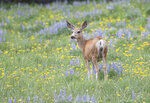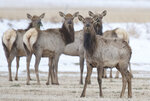Clear, 56° F
Before heading out be sure to review the 2023 hunting regulations for any season changes.
Hunters who harvest a deer or elk in any of the state’s chronic wasting disease focus areas are …
This item is available in full to subscribers.
The Powell Tribune has expanded its online content. To continue reading, you will need to either log in to your subscriber account, or purchase a subscription.
If you are a current print subscriber, you can set up a free web account by clicking here.
If you already have a web account, but need to reset it, you can do so by clicking here.
If you would like to purchase a subscription click here.
Please log in to continue |
|





Before heading out be sure to review the 2023 hunting regulations for any season changes.
Hunters who harvest a deer or elk in any of the state’s chronic wasting disease focus areas are encouraged to get it tested. The information is valuable and will help Game and Fish’s long-term monitoring and management efforts.
Hunters are reminded to be mindful of the spread of invasive plant species and to report locations of cheatgrass to the county Weed and Pest District.
Hunters are reminded to be bear-aware when recreating this fall. Hunters should take the necessary safety precautions and be on the lookout for bears — and signs of bears.
Big game hunters are reminded that hunt areas denoted with an asterisk (*) have limited public hunting access and are largely comprised of private lands. In these areas, hunters should get permission to hunt private land before applying for a license, or at least recognize that hunting small isolated parcels of public land can be difficult and frustrating at times.
Deer
Winter survival appears to be at or above average throughout the region. Based on preliminary field observations, mule deer fawn production appears to be similar or better than last year. The region observed improved fawn production in most deer herds during the 2022 deer classifications. Most mule deer herds within the region are currently below population management objectives. Hunters should expect conditions and success to be similar or slightly improved compared to 2022. Prolonged drought and increasing CWD prevalence have had a negative impact on Bighorn Basin deer herds over the past several years. Managers are hopeful the recent positive trends in precipitation will provide a needed boost to mule deer populations.
Elk
Most herds continue to perform well within the region, with several at or above management objectives. Based on improved precipitation and early field observations suggesting good calf production, elk hunters should expect good hunting within the Cody Region again this year.
Moose
Herds within the region have been performing better over the past several years. The Bighorn Mountain herd has recorded high trend counts for the past four years. Research conducted within the Absaroka herd (Hunt Area 9) suggests good calf production and survival in 2023. Managers are observing a slight increase in moose numbers in Hunt Area 11, particularly within the Sunlight Basin area. Moose licenses changed slightly this year to balance the new 90:10 resident/nonresident allocation. Moose hunters should expect good moose hunting conditions and success in 2023.
Bighorn Sheep
The Absaroka (Hunt Areas 1-5) and Devil’s Canyon (Hunt Area 12) herds are within the Cody Region. Sheep numbers are within management objectives for the Absaroka herd and have recently fallen below objective within the Devil’s Canyon herd due to a recent disease die-off. It is estimated that the die-off reduced the Devil’s Canyon herd by 40%, but we have observed promising lamb recruitment thus far and anticipate the herd will recover quickly. Ram licenses within the Devil’s Canyon herd were reduced to two licenses and ewe licenses were removed for the 2023 season. Licenses within the Absaroka herd were adjusted to align with the new 90:10 resident/nonresident license allocation. Overall, licenses within the Absaroka herd increased slightly for the 2023 season. Those fortunate to have drawn bighorn sheep licenses within the region should enjoy good hunting.
Mountain Goat
The Beartooth herd (Hunt Areas 1, 3 and 5A) is within its population management objective. The season structure has been designed to provide harvest opportunity in Hunt Area 3 while maintaining harvest levels within Hunt Area 1. Licenses in Hunt Area 3 were reduced for the 2023 seasons as goat populations are nearing their management objectives. Mountain goat licenses were adjusted to align with the new 90:10 resident/nonresident license allocation. Those fortunate enough to have drawn a goat license should have a good goat hunt.
Pronghorn
Pronghorn populations and hunting success continue to be down through much of the Big Horn Basin and licenses have been reduced or maintained for the 2023 season in most of these areas. The northern portion of the Big Horn Basin’s pronghorn herds are relatively stable. Early field observations suggest good fawn production throughout much of the region. Hunting should be similar or better for those who drew pronghorn licenses within the region than last year.
Upland Game and Small Game
The region has received more precipitation than last year at this time, thus improving upland/small game habitats. Upland bird hunters should expect similar or slightly improved hunting conditions compared to last year. Chukar and Hungarian partridge populations are rebounding but still aren’t at the peak of their cycles and field managers aren’t seeing as many broods as they usually do when populations are high. Early observations from field managers suggest sage-grouse production may have improved from last year. Rabbit hunting should be similar or slightly improved from last season. Squirrel hunting should be excellent this year in the Cody Region.
Wildlife disease management
Hunters are encouraged to assist wildlife managers in collecting disease samples. Elk hunters who receive a brucellosis sample kit in the mail should carry the sample kit while in the field and collect a blood sample from their harvest. Hunters should be aware that there are mandatory sample submission and focus sampling areas within the region for CWD. Mandatory CWD sample submission is required for hunters who hold a Type 1 license for Hunt Areas 41 and 47. In addition, elk hunters are encouraged to submit a CWD sample for Hunt Areas 55, 56, 58-61 and 66. Hunters can have their deer or elk tested for CWD by collecting a sample themselves and sending it to the Wildlife Health Lab or by bringing the head to a Game and Fish regional office during office hours or game check station.
Weather and habitat conditions
The 2002-23 winter was near the 10-year average to slightly above average across the region. Spring and summer conditions throughout the region have produced above-average precipitation and lower temperatures through July. These types of conditions bode well for wildlife within the region. Wildlife populations should benefit if conditions continue and there is good late-summer/fall precipitation.
MIGRATORY GAME BIRDS - STATEWIDE
Wetland and overall water conditions in Wyoming are much improved from last year. Precipitation in spring and through the summer in much of the state has provided very good breeding conditions for local birds. There could be above-average success for local broods and improved habitat to pull in migrants in the fall and winter. Conditions in the Prairie Potholes of the United States and Canada are variable but below average in Alberta, where many of Wyoming’s harvested ducks are produced. Migration chronology and weather, as well as hunter efforts of scouting for birds and obtaining permission to hunt private land when necessary, will influence the success of migratory bird hunters throughout the state. Before heading out be sure to review the 2023 hunting regulations for any season changes.
Ducks
Most of Wyoming’s migrating ducks come from the U.S. and Canadian prairies. Initial reports indicate dry conditions in southern Alberta, northern Montana and parts of the Dakotas. Overall habitat conditions appear mixed for duck production, but local conditions in much of Wyoming appear excellent. Average to below-average duck numbers can be expected.
Geese
Canada geese harvested in the state come from two populations. The Rocky Mountain population can be found west of the Continental Divide in the Wind River and Bighorn River basins and in western Carbon and Natrona counties. Large geese found in eastern Wyoming belong to the Hi-Line population. Goose numbers in recent years have been consistently high. Canada goose numbers during hunting season are usually driven by winter conditions and there should be plenty of geese present should the weather cooperate.
Mourning doves
Production within Wyoming in 2023 appears to be above average, likely due to the precipitation and wetter-than-usual conditions extending into the summer. Most doves will migrate out of the state with the first cold snap, usually between late August and mid-September. Doves from northern areas migrate through the state in mid-September and good hunting can still be found after the first few days of the season.
Sandhill Crane
Cranes that migrate through eastern Wyoming — Hunt Area 7 — are primarily from the Mid-Continent population, which has been relatively stable since the early 1980s and exceeds the established objective range of 349,000–472,000. Cranes that breed and stage in central and western Wyoming —Hunt Areas 1-6, and 8 — are from the Rocky Mountain population. The fall pre-migration survey in 2022 remained high. Cranes in Hunt Areas 4 and 6 tend to roost and feed in the same locations every year. Roost locations in Hunt Area 4 are Hidden Valley, Riverview Valley and the south side of Ocean Lake. Roost locations in Hunt Area 6 are north of Worland, the Otto area, from Powell to Ralston and Ralston Reservoir. For best success, scout for cranes before the season and obtain permission to access the fields they use.
Sage Grouse
In Hunt Area 1, which covers the western half of Wyoming, the 2023 sage grouse hunting season is similar to last year with the exception of a date shift to keep opening day anchored to the third Saturday in September. Hunt Area 1 opens Sept. 16 and closes Sept. 30. One major change is Hunt Area 4, which covers northeast Wyoming, is now closed. Sage-grouse numbers will be similar to the last few years and hunters should expect low to moderate success rates. Sage grouse populations appear to be stabilizing and trending slightly upward in some areas as their population cycle continues. The number of birds harvested each year is strongly related to hatching success and over-summer chick survival. Preliminary statewide population data shows minimal effects of this past spring’s persistent winter conditions that delayed lek attendance.